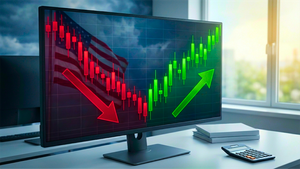Financial News
Navigating the Crosscurrents: A Comprehensive Look at Today's Stock Market

Early September 2025 finds the U.S. stock market at a pivotal and complex juncture. After a robust summer rally that saw major indices achieve significant gains, including the S&P 500 (SPX) reaching its 20th record high of the year in August, a renewed sense of caution has settled in. The market has started September with a downturn across all major indices, facing a confluence of historically volatile seasonal factors and a delicate balance of anticipated Federal Reserve policy shifts, persistent inflation, evolving trade dynamics, and a volatile global geopolitical landscape.
This period is characterized by market resilience tempered by inherent vulnerabilities. Despite near-record highs, recent pullbacks underscore investor sensitivity to conflicting signals. The overarching narrative is one of delicate balance, where the promise of a potential Federal Reserve interest rate cut is weighed against stubborn price pressures, legal challenges to trade tariffs, and an unpredictable international stage.
A Market in Flux: Federal Reserve, Inflation, and Global Headwinds
The U.S. stock market's journey through late summer and into early autumn 2025 has been marked by significant crosscurrents. After a generally positive August that saw the Dow Jones Industrial Average (DJIA) advance 3.2%, the S&P 500 (SPX) gain 1.9%, and the Nasdaq Composite (IXIC) rise 1.6%, September has opened with a distinct shift towards caution. On September 2nd, the Dow fell 0.8%, the S&P 500 tumbled over 1%, and the Nasdaq slid 1.3%, signaling a challenging start to what is historically the weakest month for U.S. stocks.
A central driver of current market sentiment is the highly anticipated move by the Federal Reserve. There is a near 90% probability of a 25-basis-point interest rate cut in September 2025, marking the first such reduction of the year. This expectation is fueled by emerging signs of a softening labor market and various signals from Fed officials. However, the market remains on edge, scrutinizing whether this cut will be perceived as "dovish," indicating a commitment to further easing, or "hawkish," suggesting a more cautious approach, depending on upcoming inflation and employment data. The political pressures surrounding the central bank's independence further complicate this outlook, adding a layer of uncertainty to future policy decisions.
Inflation remains a persistent and "sticky" concern, consistently hovering above the Fed's 2% target. The U.S. personal consumption expenditures (PCE) price index, the Fed's preferred inflation gauge, registered a 2.9% annual rate for core inflation and 2.6% for headline inflation in July. This persistent price pressure reinforces the challenge of achieving the "last mile" of disinflation, keeping the Fed firmly in the spotlight and its every move meticulously analyzed by investors.
Adding another layer of complexity is the re-emergence of tariff uncertainty. A recent appeals court ruling challenging the legality of President Trump’s "reciprocal" tariffs has injected significant unease into global trade dynamics. While these tariffs remain in effect until mid-October, pending a potential Supreme Court appeal, the ruling has brought to the forefront the substantial impact trade policy can have on corporate supply chains, consumer prices, and overall economic growth. Companies reliant on international trade, particularly those with complex global supply networks, are now closely monitoring these legal developments.
Finally, a volatile global geopolitical landscape continues to cast a shadow over market confidence. Ongoing conflicts and diplomatic tensions contribute to market volatility, often driving demand for safe-haven assets and influencing commodity prices. This persistent backdrop of geopolitical risk acts as a constant reminder of external factors that can swiftly disrupt market stability and investor sentiment.
Market Movers: Winners and Losers in a Volatile Landscape
In the current intricate market environment of early September 2025, a diverse array of companies and sectors are poised to either benefit from or be challenged by the prevailing economic crosscurrents. The interplay of anticipated Federal Reserve rate cuts, persistent inflation, evolving trade policies, and geopolitical risks is creating a distinct landscape of potential winners and losers.
The technology sector, while having enjoyed a robust summer rally, is facing increasing scrutiny. Valuations for many major technology and AI stocks are perceived as stretched, leading to significant profit-taking. Companies like Marvell Technology Inc. (NASDAQ: MRVL) experienced a substantial 18.6% plunge after disappointing revenue forecasts, highlighting the market's sensitivity to performance shortfalls in highly valued segments. Even industry titans like Nvidia Corp. (NASDAQ: NVDA) have seen declines, reflecting a cooling of the initial, fervent optimism surrounding artificial intelligence. As the market enters a potentially more volatile phase, tech companies with strong fundamentals, diversified revenue streams, and clearer paths to profitability may weather the storm better than those whose valuations rely heavily on speculative growth.
Conversely, a Federal Reserve rate cut, if indeed perceived as dovish, could offer a tailwind for growth-oriented companies and sectors that are sensitive to borrowing costs, such as housing and certain consumer discretionary businesses. Lower interest rates typically reduce the cost of capital, making it cheaper for companies to invest and expand, and for consumers to borrow and spend. However, the "sticky" nature of inflation means that the benefit of rate cuts might be partially offset by persistent input cost pressures for businesses and reduced purchasing power for consumers. Companies with strong pricing power and efficient supply chain management will be better positioned to navigate inflationary environments.
The re-emergence of tariff uncertainty poses a significant threat to companies deeply embedded in global supply chains. Manufacturers, retailers, and any business relying on international trade for raw materials, components, or finished goods could face increased costs, disrupted logistics, and reduced profitability if tariffs are reinstated or expanded. Conversely, domestic producers in sectors that historically faced foreign competition might see a temporary advantage, though the broader economic disruption from trade wars often negates these benefits. Companies with agile supply chains and diversified manufacturing bases will be better equipped to adapt to potential changes in trade policy.
Finally, persistent geopolitical risks often drive investors towards traditional safe-haven assets and companies in less cyclical, more stable sectors. This could include utilities, consumer staples, and certain healthcare companies, which tend to be less volatile during periods of global uncertainty. Defense contractors and companies involved in national security may also see increased demand. On the other hand, sectors highly dependent on global stability, such as international travel and tourism, or those with significant exposure to geopolitical flashpoints, could face headwinds.
Industry Impact and Broader Implications: Navigating Uncertainty
The current financial landscape is not merely a collection of isolated events but rather an intricate tapestry woven from macroeconomic forces, regulatory shifts, and global dynamics. The developments in early September 2025, particularly around Federal Reserve policy, inflation, and trade, are poised to have far-reaching implications across various industries.
The anticipated Federal Reserve rate cut, while potentially signaling a more accommodative stance, arrives amidst persistent inflation. This delicate balance means that while some industries, particularly interest-rate sensitive sectors like real estate (XLRE) and automotive, might initially breathe a sigh of relief from lower borrowing costs, they will simultaneously grapple with elevated input costs and potentially constrained consumer spending due to persistent price pressures. For instance, homebuilders might see increased demand due to more affordable mortgages, but rising costs for materials and labor could squeeze their margins. The financial services sector will also be closely watching the yield curve; while lower rates can stimulate lending, a flattening or inverted curve can compress bank profit margins.
The appeals court ruling challenging the legality of existing tariffs introduces a significant element of regulatory uncertainty. Should the Supreme Court uphold the ruling, it could lead to a dramatic reshaping of global supply chains and trade relationships that have been in place for years. Industries heavily reliant on imported goods, such as retailers (e.g., Walmart Inc. (NYSE: WMT), Target Corporation (NYSE: TGT)) and electronics manufacturers (e.g., Apple Inc. (NASDAQ: AAPL), which has extensive supply chains in Asia), could see a reduction in import costs, potentially boosting their profitability and offering consumers lower prices. Conversely, domestic industries that benefited from tariff protection might face renewed competition. This situation harks back to the trade wars of the late 2010s, where businesses scrambled to reconfigure their operations, illustrating the profound impact that abrupt policy shifts can have on global commerce. The potential for the Supreme Court's involvement elevates this from a mere trade dispute to a constitutional matter with potentially sweeping ramifications for presidential authority over trade policy.
Broader industry trends are also shaped by the ongoing push for artificial intelligence (AI). While initial AI optimism has cooled slightly, the transformative potential remains. Industries like software and services, semiconductors, and cloud computing are still at the forefront of AI integration, driving innovation and efficiency. However, the high valuations in some AI-related companies are being recalibrated, suggesting a shift towards valuing demonstrable profitability and sustainable growth rather than just potential. This could lead to consolidation in the AI space and a greater emphasis on practical applications across various sectors, from healthcare to logistics.
Geopolitical risks continue to fuel uncertainty, particularly impacting global energy markets and sectors with significant international exposure. Any escalation could lead to spikes in oil and gas prices, directly affecting transportation, manufacturing, and consumer costs. This also reinforces the trend towards reshoring or friend-shoring of supply chains, as companies seek to reduce their vulnerability to international disruptions, potentially benefiting domestic manufacturing and logistics providers.
The Road Ahead: Opportunities and Challenges
As the U.S. stock market navigates the complex landscape of early September 2025, both short-term and long-term possibilities present themselves, along with a distinct set of challenges and opportunities for investors and corporations alike. The coming months will be highly sensitive to incoming economic data and central bank communications, demanding strategic agility.
In the short term, the primary focus will undoubtedly be on the Federal Reserve's actions. While a 25-basis-point rate cut in September is largely priced in, the market will meticulously dissect the Fed's forward guidance. Will it signal a clear path for further cuts, or will it adopt a more cautious, data-dependent stance? This will dictate investor sentiment and immediate market reactions. The August jobs report, scheduled for release on September 5th, along with subsequent inflation data, will provide crucial inputs for the Fed's decision-making and market expectations. A significantly weaker jobs report or cooling inflation could embolden a more dovish Fed, potentially offering a short-term boost to equities, particularly growth stocks.
Looking further ahead into late 2025 and beyond, the market is poised to remain highly sensitive to these macroeconomic variables. Corporate earnings, especially from the resilient technology sector, are expected to continue providing fundamental support. However, stretched valuations in some areas, coupled with ongoing inflation and geopolitical headwinds, could lead to increased choppiness and sector rotations. Companies will need to continue demonstrating strong earnings growth and efficient cost management to justify their valuations. Strategic pivots might include a continued focus on operational efficiency, hedging against currency fluctuations, and diversifying supply chains to mitigate geopolitical and trade-related risks.
Market opportunities may emerge from specific themes. The transformative potential of artificial intelligence continues to be a long-term driver, with companies that successfully integrate AI into their operations or develop essential AI infrastructure likely to see sustained growth. As the Federal Reserve potentially moves into a more accommodative stance, sectors that suffered during the tightening cycle, such as small-cap companies (IWM) and certain cyclical industries, could experience a resurgence. Conversely, challenges include navigating persistent inflation, which eradicates purchasing power and corporate margins, and adapting to an unpredictable global political environment that can swiftly impact trade flows and investor confidence.
Potential scenarios range from a "soft landing," where inflation gradually cools, and the Fed manages a series of well-timed rate cuts, leading to sustained market growth, to a more challenging environment if inflation proves more stubborn or geopolitical tensions escalate significantly, potentially leading to increased volatility or even a shallow recession. Investors should prepare for a range of outcomes, emphasizing robust risk management.
Conclusion: A Market in Flux
Early September 2025 finds the U.S. stock market at a pivotal and complex juncture, having navigated a robust summer rally only to confront a renewed sense of caution as it enters a historically volatile month. The overarching narrative is one of delicate balance: a market displaying resilience and near-record highs, yet grappling with the intricate interplay of anticipated Federal Reserve policy shifts, the stubborn persistence of inflation, evolving trade dynamics, and a volatile global geopolitical landscape.
The key takeaways from this period underscore the market's adaptability but also its inherent vulnerabilities. While major indices have generally performed well, recent pullbacks highlight investor sensitivity to conflicting signals. Inflation remains a central and sticky concern, consistently hovering above the Fed's 2% target, proving that the "last mile" of disinflation is indeed the most challenging. This persistent price pressure keeps the Federal Reserve firmly in the spotlight, with a widely anticipated 25-basis-point rate cut in September, marking the first of 2025. However, the exact nature and subsequent pace of these cuts will be closely scrutinized, with political pressures on the central bank's independence adding a layer of complexity. Furthermore, the re-emergence of tariff uncertainty, particularly after a recent appeals court ruling challenging their legality, reminds investors of the significant impact trade policy can have on corporate supply chains, consumer prices, and overall economic growth. Persistent geopolitical risks continue to cast a shadow, contributing to market volatility and driving demand for safe-haven assets.
Moving forward into late 2025 and beyond, the market is poised to remain highly sensitive to incoming economic data and central bank communications. Corporate earnings, especially from the technology sector, are expected to continue providing fundamental support, but stretched valuations in some areas, coupled with ongoing inflation and geopolitical headwinds, could lead to increased choppiness. The long-term outlook, however, remains cautiously optimistic, largely fueled by the transformative potential of artificial intelligence and an expected acceleration in corporate profits as the Federal Reserve potentially moves into a more accommodative stance.
For investors, vigilance and strategic agility will be paramount. Close monitoring of Federal Reserve communications, particularly on forward guidance after any rate cuts, is essential. Watching inflation data, especially the PCE index, will provide crucial insights into the Fed's future decisions. Developments in trade policy, including the Supreme Court's potential involvement in tariff rulings, will shape global supply chains and corporate profitability. Lastly, the persistent global geopolitical landscape demands attention, as escalations can swiftly impact energy prices, trade flows, and overall investor confidence. In this evolving market, maintaining a diversified portfolio, focusing on quality companies, and adopting a long-term perspective while staying informed on these key macroeconomic and geopolitical drivers will be crucial for navigating the crosscurrents and achieving sustainable returns.
More News
View More




Recent Quotes
View MoreQuotes delayed at least 20 minutes.
By accessing this page, you agree to the Privacy Policy and Terms Of Service.



